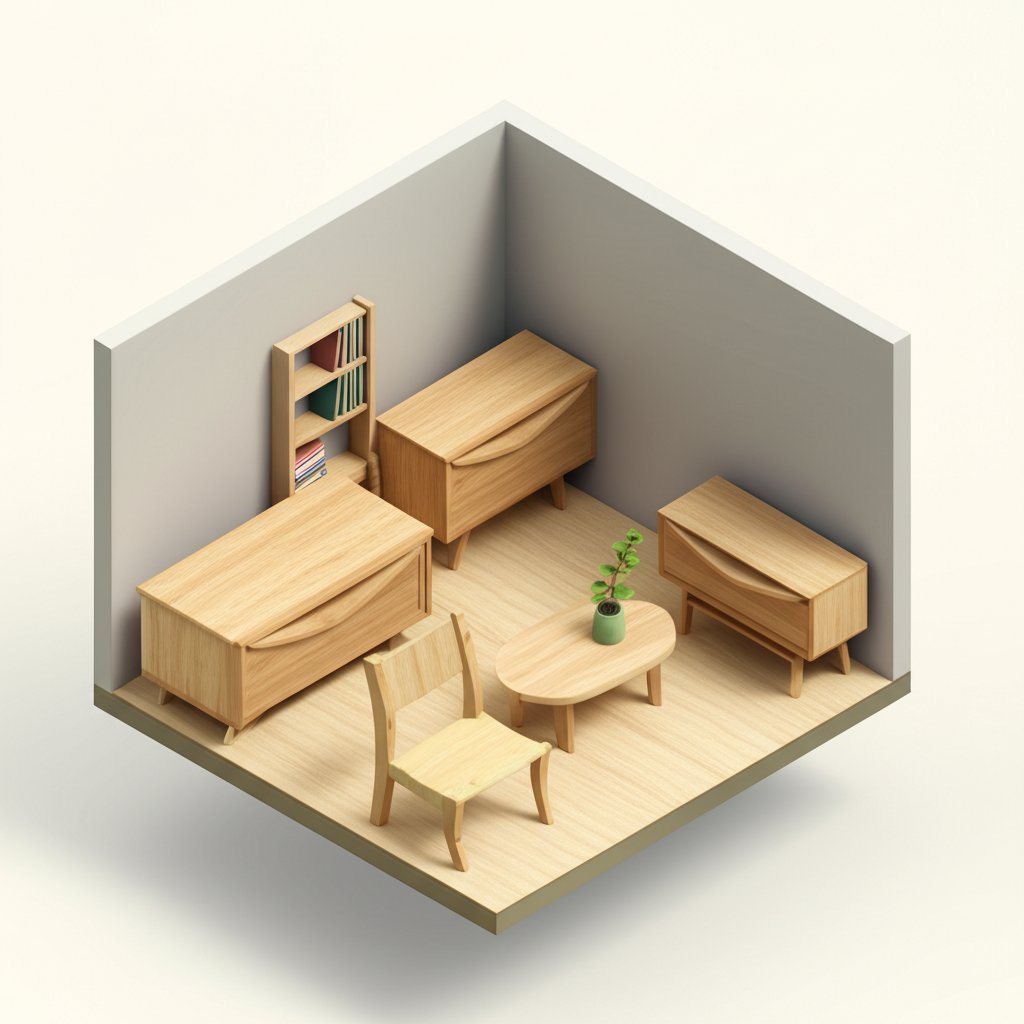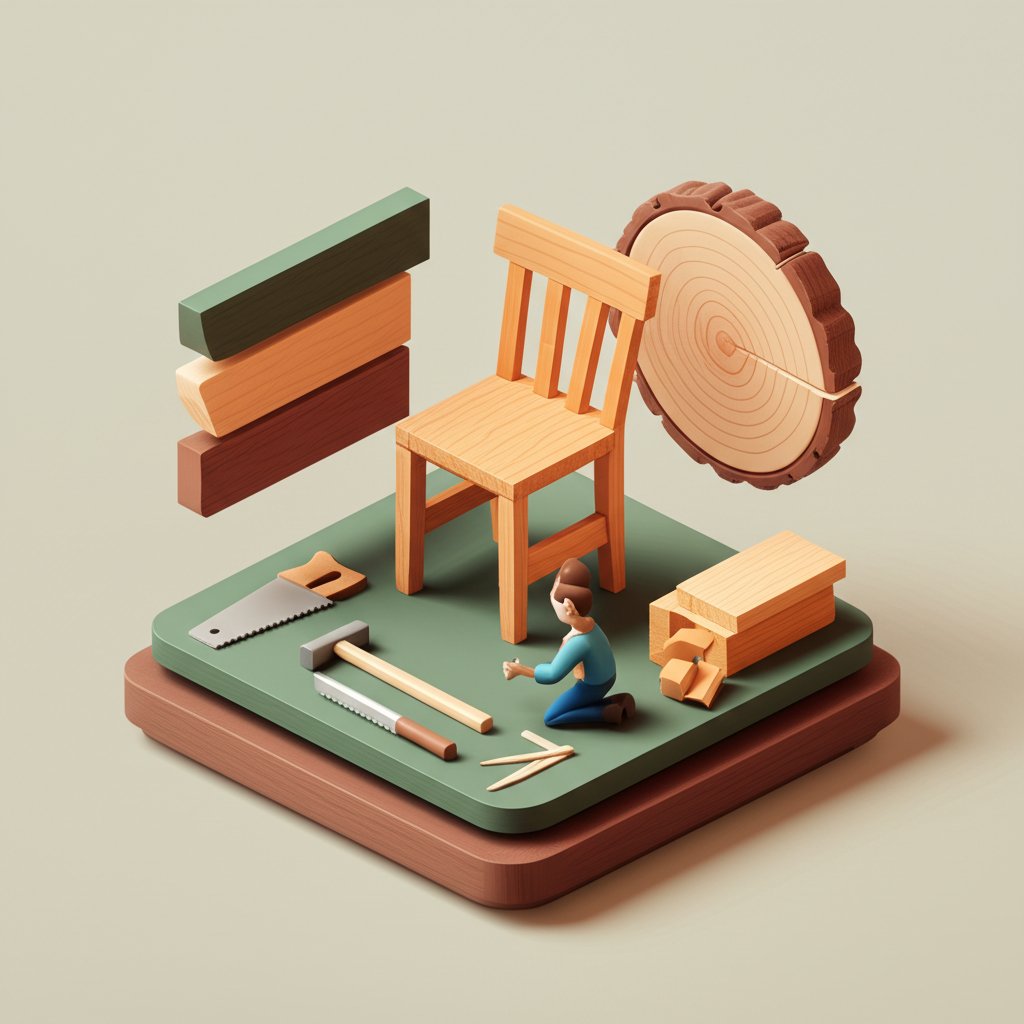Step into any well-appointed home, and you’re likely to find a piece of wooden furniture that grounds the space, adding warmth, character, and an undeniable sense of history. More than just functional objects, these pieces are silent storytellers, whispering tales of ancient forests, skilled hands, and generations of human life. But how often do we truly pause to consider the deep roots, fascinating qualities, and intricate processes behind these enduring treasures?
This article invites you on a captivating journey to uncover the enigmatic origins of wooden furniture, shed light on astonishing facts about wooden furniture, and reveal the closely guarded craftsmanship secrets that transform simple timber into timeless art. Prepare to deepen your appreciation for the material that has shaped our living spaces for millennia, as we explore the enduring legacy of wood furniture.
The Enduring Legacy: Origins of Wooden Furniture Through Time

The story of wooden furniture is as old as civilization itself, evolving from the rudimentary shelters and tools of early humans to the sophisticated masterpieces gracing modern homes. Its history is a testament to wood’s versatility and mankind’s ingenuity.
From Primitive Tools to Ancient Civilizations (Prehistory – ~500 BCE)
Long before dedicated “furniture” existed, early humans utilized wood for basic necessities. Fallen branches and carved logs served as primitive seating, makeshift tables, and storage. The true genesis of design and intentional construction, however, began with organized societies.
The ornate stools and chests crafted in ancient Egypt offer a glimpse into early woodworking, and further insights into the broader world of furniture making can be found in more detailed resources.
- Ancient Egypt (c. 3100 – 30 BCE): The Egyptians are credited with some of the earliest sophisticated wooden furniture. They mastered joinery techniques like dovetailing and mortise and tenon, creating ornate stools, chests, and beds. Here, wooden furniture wasn’t just practical; it was a powerful status symbol. Historical records and archaeological finds show that chairs, for instance, were reserved for the very wealthy, with the height of the chair’s legs often signifying the owner’s social standing. The taller the chair, the higher the status. Their pieces, often made from cedar, sycamore, or acacia, were frequently inlaid with ivory, ebony, and precious metals.
- Mesopotamia & Indus Valley (c. 3500 – 1500 BCE): Evidence suggests simpler, functional wooden pieces for seating and storage, though due to the climate, fewer intact examples remain.
- Ancient China (c. 2000 BCE onwards): Early Chinese woodworking was highly advanced, producing intricate lacquered chests and low tables. Over centuries, they refined techniques that would later influence global furniture craftsmanship.
Medieval Europe and the Rise of Craft Guilds (500 CE – 1500 CE)
Following the fall of Rome, European furniture design largely embraced functionality and durability. Heavy, sturdy pieces were crafted, primarily from local woods like oak and chestnut.
- Necessity over Ornamentation: Most medieval wooden furniture was built for practical use, with chests serving dual purposes as seating and storage. Tables were often trestle-style, easily disassembled when not needed.
- The Guild System: As society progressed, specialized craft guilds emerged, protecting trade secrets and ensuring high standards of furniture craftsmanship. Joiners, turners, and carvers each played a vital role, passing down techniques through apprenticeships. This period laid the groundwork for future advancements in woodworking.
The Renaissance and Baroque Flourish (1500 CE – 1750 CE)
The Renaissance ignited a passion for art and classical design, profoundly impacting wood furniture. Italy, France, and England became centers of innovation.
- Artistic Revival: Furniture transformed from mere utility to works of art. Elaborate carvings, intricate marquetry (inlaying different wood veneers to create patterns), and detailed gilding became hallmarks. Cabinets, armoires, and grand beds reflected the wealth and taste of their owners.
- Exotic Woods and New Techniques: The Age of Exploration introduced new, luxurious timbers like mahogany and ebony, valued for their rich colors and durability. This spurred further experimentation in furniture craftsmanship and design.
The Industrial Revolution and Mass Production (1750 CE – 1900 CE)
The 18th and 19th centuries brought revolutionary changes, as steam power and machinery began to transform production processes.
- Automation and Accessibility: New woodworking machines made it possible to produce wooden furniture faster and more affordably. This meant furniture, once exclusive to the wealthy, became more accessible to the burgeoning middle class.
- Rise of New Styles: While mass production led to some standardization, it also allowed for rapid dissemination of new styles like Neoclassical, Victorian, and Art Nouveau, influencing homes across the globe. Handcrafted pieces, however, remained highly prized for their unique artistry and superior furniture craftsmanship.
Modern Era: Design, Sustainability, and Customization (1900 CE – Present)
The 20th and 21st centuries have seen an explosion of design movements, a renewed focus on sustainability, and a blend of artisanal and factory production.
- Mid-Century Modern and Beyond: Designers explored new forms and functions, leading to iconic wood furniture pieces from movements like Bauhaus, Mid-Century Modern, and Scandinavian design, emphasizing clean lines and practicality.
- Sustainability and Reclaimed Wood: With growing environmental awareness, the origins of wood and sustainable forestry practices have become critical. Reclaimed or recycled wood furniture, often from old barns or salvaged timber, offers a unique aesthetic and an eco-friendly choice, celebrating the material’s past life.
- The Best of Both Worlds: Today, consumers can choose from mass-produced, affordable wooden furniture or invest in bespoke, handcrafted pieces that continue the legacy of traditional furniture craftsmanship.
Beyond the Grain: Fascinating Facts About Wooden Furniture
Wooden furniture captivates not just with its history, but with a myriad of inherent qualities that make it truly remarkable. These fascinating facts about wooden furniture reveal why it remains a perennial favorite.
Durability That Spans Centuries
One of the most compelling facts about wooden furniture is its incredible longevity. When properly cared for, wood is an exceptionally durable material, capable of withstanding the test of time for hundreds, even thousands, of years.
- Living Legacy: Many pieces of antique wooden furniture regularly become cherished heirlooms, passed down through generations. This is a testament to the quality of the material and the skill of the original artisans. The Horyu-ji temple in Japan, for instance, constructed in the 7th century, stands as the oldest surviving wooden building in the world, showcasing wood’s unparalleled endurance.
- Environmental Factors: While robust, wood is a natural material that can react to its environment. Extreme fluctuations in temperature and humidity can cause wood to expand, contract, warp, or crack. Consistent, moderate conditions are key to preserving its integrity.
The Unique Character of Each Wood Type
No two pieces of wood furniture are ever exactly alike, thanks to the inherent variations in timber. The choice of wood profoundly impacts a piece’s appearance, feel, and performance.
- Grain Patterns and Colors: Each species boasts a distinctive grain pattern, from the prominent, open grain of oak to the fine, straight grain of maple. Colors range from the familiar golden warmth of oak and the distinctive honey hues of walnut to the rich reddish tones of cherry wood, or the deep, dark exoticism of ebony. These natural variations ensure every piece tells its own visual story.
- Aromatic Scents: Many types of wood possess unique aromatic properties. Cedar is famous for its distinct, insect-repelling fragrance, while pine has a fresh, resinous scent, and sandalwood offers a sweet, earthy aroma. These subtle scents contribute to the sensory experience of owning wooden furniture.
- Hardwoods vs. Softwoods:
- Hardwoods (from deciduous trees like oak, maple, cherry, walnut) are generally denser, more durable, and resistant to dents and scratches, making them ideal for high-traffic wood furniture.
- Softwoods (from coniferous trees like pine, cedar, fir) are typically lighter, more affordable, and easier to work with, often lending themselves to more rustic or painted finishes.
Wood’s Versatile Nature and Practical Qualities
Beyond its beauty, wood possesses a remarkable combination of practical qualities that have made it an ideal material for wooden furniture throughout history.
- Strength-to-Weight Ratio: Wood is surprisingly strong for its weight, offering a good balance of durability and relative ease of movement for furniture.
- Workability: It’s soft enough to be cut, carved, and shaped into intricate designs, yet strong enough to hold those forms for centuries. This unique blend has allowed for an enormous diversity in furniture craftsmanship.
- Natural Insulation: Wood has excellent insulating properties, making wooden surfaces feel warmer to the touch than metal or stone, contributing to a comfortable living environment.
- Acoustic Properties: Wood is often used in musical instruments and concert halls due to its ability to absorb and resonate sound, contributing to the ambiance of a room.
- A “Living” Material: Even after being harvested and crafted, wood continues to respond to its environment, subtly changing over time, developing a unique patina that enhances its character and depth.
The Art and Science: Mastering Furniture Craftsmanship
The creation of beautiful and lasting wooden furniture is a profound blend of artistic vision, scientific understanding of materials, and generations of honed skill. Furniture craftsmanship is a discipline that marries precision with passion, transforming raw timber into functional art.
From Tree to Timber: Lumber Selection and Preparation
The foundation of exceptional wood furniture lies in the very first step: selecting the right wood and preparing it correctly.
- Understanding Wood Characteristics: A skilled craftsman intimately understands the grain, figure, color, and potential defects (knots, checks) of different wood species. They choose lumber not just for its appearance, but for its stability and suitability to a specific design.
- Seasoning and Drying: Freshly cut wood contains a high moisture content, which must be reduced to prevent warping, cracking, and shrinkage in the finished piece.
- Air Drying: A natural, slower process where wood is stacked to allow air circulation.
- Kiln Drying: A controlled, accelerated process using heat and humidity to achieve uniform moisture content, essential for modern precision furniture craftsmanship.
Properly dried wood is stable, ensuring the longevity and structural integrity of the furniture.
The Mastery of Joinery Techniques
True furniture craftsmanship is evident in its joinery – the methods used to connect pieces of wood. Beyond simple nails and screws, traditional joinery creates robust, elegant connections that can last for centuries.
- Form and Function: Each joint is chosen for its specific purpose, balancing strength, appearance, and ease of construction.
- Key Joinery Types:
- Mortise and Tenon: A strong, classic joint where a projection (tenon) fits into a cavity (mortise). Ideal for frames and legs.
- Dovetail Joint: Renowned for its strength and aesthetic appeal, especially in drawer construction, preventing joints from pulling apart.
- Finger Joint (Box Joint): A series of interlocking “fingers” that provides a large gluing surface, good for box corners.
- Lap Joint: Where two pieces overlap and are joined, often used where strength is needed in a broad surface.
- Precision and Durability: Masterful joinery avoids metal fasteners that can corrode or loosen, instead relying on precise wood-to-wood contact, often reinforced with glue, to create an incredibly strong and durable structure.
Hand Tools vs. Modern Machinery
The evolution of furniture craftsmanship has seen a dynamic interplay between traditional hand skills and contemporary technology.
- Traditional Hand Skills: The foundation of fine furniture making still relies on chisels, hand planes, saws, and scrapers. These tools allow for an intimate connection with the wood, enabling subtle refinements, intricate carvings, and a level of artistry that machines cannot replicate. The hand-carved details seen in many artisanal pieces, like those from Burnside of Ballintomb, exemplify this dedication to traditional methods.
- The Rise of Machinery: Power tools and stationary machinery (saws, routers, jointers, planers) dramatically increase efficiency and precision for stock preparation and repetitive tasks. They’ve made wooden furniture production faster and more consistent.
- Harmonious Integration: Today’s top artisans often blend both approaches: using machines for initial rough cuts and dimensioning, then turning to hand tools for the intricate joinery, shaping, carving, and final finishing that define exceptional furniture craftsmanship.
Shaping, Carving, and Embellishment
Once the basic structure is defined, craftsmen impart unique character through shaping and decoration.
- Bending Techniques:
- Steam Bending: Heating wood with steam makes it pliable, allowing it to be bent into various curves, then held in form until it dries and retains its new shape.
- Laminate Bending: Thin strips of wood are glued together over a form to create strong, curved components.
- Carving and Turning: From delicate relief carvings that tell stories on cabinet doors to the graceful curves achieved through wood turning on a lathe for table legs, these techniques add artistic flair.
- Marquetry and Inlay: These decorative arts involve creating elaborate patterns by fitting together small pieces of different colored wood veneer (marquetry) or embedding contrasting materials (like shell or metal) into the wood surface (inlay).
The Final Flourish: Surface Preparation and Finishing
The finishing process is crucial for protecting the wood, enhancing its natural beauty, and defining the piece’s aesthetic.
- Surface Preparation: Meticulous sanding, scraping, and polishing remove imperfections, creating a smooth, inviting surface that allows the wood’s natural grain to shine.
- Choosing the Right Finish: The choice of finish depends on the desired look, protection level, and intended use.
- Oils: Penetrate the wood, enhancing its natural luster and offering a soft, tactile feel. Easy to repair.
- Varnishes/Lacquers: Create a durable, protective film on the surface, offering high resistance to scratches and moisture.
- Waxes: Provide a low-sheen, natural look and offer some protection, often used over other finishes.
- Application Techniques: Expert application ensures an even, flawless finish that both beautifies and preserves the wood furniture for generations.
Choosing Your Legacy: Types of Wooden Furniture and Their Characteristics
Understanding the different types of wood is key to appreciating and selecting quality wooden furniture. Each species brings its own set of characteristics to the aesthetic and functional properties of a piece.
Hardwoods: Strength and Durability
These woods come from deciduous trees (those that lose their leaves in autumn) and are generally denser and more durable.
- Oak: A timeless classic, known for its distinct open grain pattern and exceptional strength. It’s highly resistant to wear and tear, making it perfect for dining tables and heavy-use items. Available in red and white varieties.
- Maple: A very dense wood with a fine, even grain. It’s incredibly durable and resistant to dents, making it a popular choice for kitchen cabinets, butcher blocks, and sturdy frames. It takes stains beautifully.
- Cherry: Prized for its smooth grain and rich, reddish-brown hue that deepens beautifully over time, developing a unique patina. It’s a moderately hard wood, often used for elegant, traditional furniture.
- Walnut: A luxurious hardwood with a naturally dark, rich chocolate-brown color and often beautiful grain patterns. It’s highly durable, dimensionally stable, and widely used for high-end wood furniture and cabinetry.
- Mahogany: A reddish-brown tropical hardwood, highly valued for its straight grain, durability, and resistance to wood rot. It’s a classic choice for fine traditional furniture, particularly antique reproductions.
Softwoods: Affordability and Versatility
These woods come from coniferous trees (evergreens) and are generally lighter and more easily worked.
- Pine: A popular and affordable softwood, characterized by its knots and light, yellowish appearance. It’s easy to work with and takes paint or stain well, often used for rustic or farmhouse-style wooden furniture.
- Cedar: Known for its aromatic scent and natural resistance to insects and rot, making it a good choice for outdoor wood furniture, chests, and closet lining.
- Fir: A relatively strong softwood for its weight, with a straight, even grain. It’s often used for structural elements or as a more economical option for certain furniture pieces.
Engineered Wood Products: Modern Solutions
While not solid wood, engineered wood plays a significant role in modern wooden furniture production, offering cost-effectiveness and stability.
- Plywood: Layers of wood veneer glued together with grains alternating, creating a strong, stable, and warp-resistant board.
- MDF (Medium-Density Fiberboard): Made from wood fibers pressed with resin, it’s smooth, uniform, and takes paint exceptionally well, ideal for painted furniture or veneers.
- Particleboard: Made from wood particles and resin, it’s the most economical option, often used as a core material for veneered or laminated surfaces.
Sustainable and Reclaimed Wood Furniture
For the environmentally conscious, sustainable and reclaimed wood furniture offers compelling alternatives.
- Sustainably Harvested Wood: Sourced from forests managed responsibly, ensuring reforestation and minimal ecological impact. Look for certifications like FSC (Forest Stewardship Council).
- Reclaimed Wood: Timber salvaged from old buildings, barns, or even underwater logs. Each piece tells a unique story with its distressed marks, nail holes, and aged patina, giving a second life to forgotten wood.
Preserving Timeless Beauty: Care and Maintenance for Wooden Furniture
Investing in wooden furniture is an investment in lasting beauty. Proper care and maintenance are essential for preserving its integrity and ensuring it truly becomes a cherished heirloom.
Everyday Care: Dusting and Cleaning
Regular, gentle care can significantly extend the life and luster of your wood furniture.
- Dust Regularly: Use a soft, lint-free cloth, preferably microfiber, to dust surfaces weekly. Dust can be abrasive and dull finishes over time.
- Clean Gently: For spills, blot immediately with a clean, dry cloth. For general cleaning, use a damp cloth (barely wet) with a very mild, non-abrasive soap. Always follow up by thoroughly drying the surface to prevent watermarks or swelling.
- Avoid Harsh Chemicals: Steer clear of silicone-based polishes or all-purpose cleaners, which can build up, create a sticky residue, and damage the wood’s finish over time.
Environmental Control: Humidity and Sunlight
Wood is a natural material that reacts to its surroundings, making environmental control crucial.
- Maintain Consistent Humidity: Wood absorbs and releases moisture, causing it to expand and contract. Dramatic fluctuations can lead to cracking or warping. Ideally, maintain a consistent humidity level in your home between 40-50%. Use humidifiers in dry climates and dehumidifiers in humid ones.
- Protect from Direct Sunlight: Prolonged exposure to direct UV rays can fade wood finishes, change wood color, and even dry out the timber, leading to cracks. Position wooden furniture away from direct sunlight or use curtains, blinds, or UV-filtering window treatments.
- Avoid Extreme Temperatures: Keep furniture away from heat sources like radiators, fireplaces, or vents, which can cause drying and cracking.
Repair and Restoration: Extending Longevity
Even with the best care, life happens. Knowing how to address minor issues or when to seek professional help can save your wood furniture.
- Minor Scratches and Dents: Many surface scratches can be minimized with touch-up pens, furniture crayons, or by rubbing with a walnut or pecan meat (natural oils can help). For dents, a damp cloth and a warm iron can sometimes lift the wood fibers.
- Professional Restoration: For significant damage, deep scratches, major structural issues, or a dull, worn finish, consult a professional furniture restorer. Their expertise in furniture craftsmanship can bring old pieces back to life.
Understanding Different Finishes and Their Needs
The type of finish on your wood furniture dictates its specific care requirements.
- Oil Finishes: These penetrate the wood, offering a natural feel. They require reapplication of oil periodically (every 6-12 months) to maintain protection and luster.
- Varnish/Lacquer Finishes: These create a protective film on the surface. They are durable but can scratch. Use mild cleaners and avoid abrasive materials.
- Wax Finishes: Often used over other finishes for a soft sheen. They need occasional re-waxing. Always apply thin coats and buff thoroughly.
Conclusion
From the earliest crafted tools to the iconic designs of today, wooden furniture stands as a profound testament to human ingenuity and our enduring connection to the natural world. We’ve journeyed through its ancient origins of wooden furniture, discovered surprising facts about wooden furniture, and peered into the complex world of furniture craftsmanship.
Each grain tells a story, each joint speaks of a skilled hand, and every piece of wood furniture holds the potential to become a cherished part of your personal legacy. By understanding its history, appreciating its unique properties, and committing to proper care, you not only preserve a beautiful object but participate in a tradition that spans millennia. Embrace the timeless elegance, durability, and character that only authentic wooden furniture can bring to your home. Invest wisely, care diligently, and let these remarkable creations enrich your life for generations to come.
FAQ

Q: How long can quality wooden furniture truly last?
A: High-quality wooden furniture, particularly pieces made from hardwoods with skilled furniture craftsmanship, can last for centuries if properly cared for. Factors like stable humidity, protection from direct sunlight, and regular maintenance significantly contribute to its longevity. Many antique pieces are still functional and beautiful today.
Q: What makes wood a unique material for furniture?
A: Wood’s uniqueness lies in its combination of properties: it’s durable yet workable, strong yet relatively light, a natural insulator, and a “living” material that responds to its environment and develops a beautiful patina over time. Each piece also has a unique grain pattern and often a distinct natural scent.
Q: What are some historical origins of wooden furniture?
A: The origins of wooden furniture date back to early civilizations, with sophisticated examples found from Ancient Egypt (c. 3100 BCE), where chairs symbolized status. Medieval Europe saw functional, sturdy pieces crafted by guilds, while the Renaissance brought back elaborate carvings and marquetry. The Industrial Revolution popularized mass production, and today’s designs also emphasize sustainability.
Q: What are the key aspects of furniture craftsmanship?
A: Key aspects of furniture craftsmanship include meticulous lumber selection and proper drying, mastery of various joinery techniques (like mortise and tenon, dovetails), expertise in both hand tools and modern machinery, artistic shaping and embellishment (carving, bending, inlay), and precise surface preparation followed by appropriate finishing to protect and enhance the wood.
Q: How do you properly care for wood furniture?
A: Proper care for wood furniture involves regular dusting with a soft cloth, gentle cleaning with a slightly damp cloth (avoiding harsh chemicals), protecting it from direct sunlight and extreme temperature fluctuations, and maintaining consistent humidity levels (ideally 40-50%). Understanding the specific needs of your furniture’s finish (oil, varnish, wax) is also important.
Q: What are the main types of wood used in wooden furniture?
A: The main types fall into two categories:










